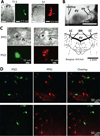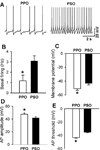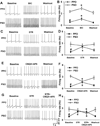Distinct intrinsic and synaptic properties of pre-sympathetic and pre-parasympathetic output neurons in Barrington's nucleus
- PMID: 23647148
- PMCID: PMC3716857
- DOI: 10.1111/jnc.12290
Distinct intrinsic and synaptic properties of pre-sympathetic and pre-parasympathetic output neurons in Barrington's nucleus
Abstract
Barrington's nucleus (BN), commonly known as the pontine micturition center, controls micturition and other visceral functions through projections to the spinal cord. In this study, we developed a rat brain slice preparation to determine the intrinsic and synaptic mechanisms regulating pre-sympathetic output (PSO) and pre-parasympathetic output (PPO) neurons in the BN using patch-clamp recordings. The PSO and PPO neurons were retrogradely labeled by injecting fluorescent tracers into the intermediolateral region of the spinal cord at T13-L1 and S1-S2 levels, respectively. There were significantly more PPO than PSO neurons within the BN. The basal activity and membrane potential were significantly lower in PPO than in PSO neurons, and A-type K(+) currents were significantly larger in PPO than in PSO neurons. Blocking A-type K(+) channels increased the excitability more in PPO than in PSO neurons. Stimulting μ-opioid receptors inhibited firing in both PPO and PSO neurons. The glutamatergic EPSC frequency was much lower, whereas the glycinergic IPSC frequency was much higher, in PPO than in PSO neurons. Although blocking GABAA receptors increased the excitability of both PSO and PPO neurons, blocking glycine receptors increased the firing activity of PPO neurons only. Furthermore, blocking ionotropic glutamate receptors decreased the excitability of PSO neurons but paradoxically increased the firing activity of PPO neurons by reducing glycinergic input. Our findings indicate that the membrane and synaptic properties of PSO and PPO neurons in the BN are distinctly different. This information improves our understanding of the neural circuitry and central mechanisms regulating the bladder and other visceral organs.
Keywords: autonomic nervous system; micturition reflex; pontine micturition center; synaptic transmission; voltage-activated K+ channels.
© 2013 International Society for Neurochemistry.
Conflict of interest statement
The authors declare that they have no conflict of interest.
Figures








Similar articles
-
Downstream projection of Barrington's nucleus to the spinal cord in mice.J Neurophysiol. 2021 Dec 1;126(6):1959-1977. doi: 10.1152/jn.00026.2021. Epub 2021 Nov 3. J Neurophysiol. 2021. PMID: 34731061
-
Connections of Barrington's nucleus to the sympathetic nervous system in rats.J Auton Nerv Syst. 2000 Mar 15;79(2-3):117-28. doi: 10.1016/s0165-1838(99)00101-0. J Auton Nerv Syst. 2000. PMID: 10699642
-
Convergent responses of Barrington's nucleus neurons to pelvic visceral stimuli in the rat: a juxtacellular labelling study.Eur J Neurosci. 2003 Dec;18(12):3325-34. doi: 10.1111/j.1460-9568.2003.03072.x. Eur J Neurosci. 2003. PMID: 14686905
-
Role of Barrington's nucleus in the activation of rat locus coeruleus neurons by colonic distension.Brain Res. 2001 Nov 2;917(2):206-18. doi: 10.1016/s0006-8993(01)02917-1. Brain Res. 2001. PMID: 11640906
-
Role of Barrington's nucleus in micturition.J Comp Neurol. 2005 Dec 5;493(1):21-6. doi: 10.1002/cne.20719. J Comp Neurol. 2005. PMID: 16255005 Review.
Cited by
-
Neurogenic mechanisms in bladder and bowel ageing.Biogerontology. 2015 Apr;16(2):265-84. doi: 10.1007/s10522-015-9554-3. Epub 2015 Feb 11. Biogerontology. 2015. PMID: 25666896 Free PMC article. Review.
-
Neural control of the lower urinary tract.Compr Physiol. 2015 Jan;5(1):327-96. doi: 10.1002/cphy.c130056. Compr Physiol. 2015. PMID: 25589273 Free PMC article. Review.
-
Effect of Alpha 1-Adrnoceptor Antagonists on Postsynaptic Sensitivity in Substantia Gelatinosa Neurons From Lumbosacral Spinal Cord in Rats Using Slice Patch-Clamp Technique for mEPSC.Int Neurourol J. 2020 Jun;24(2):135-143. doi: 10.5213/inj.1938250.125. Epub 2020 Jun 30. Int Neurourol J. 2020. PMID: 32615675 Free PMC article.
-
Characterization on Responsiveness of Excitatory Synaptic Transmissions to α1-Adrenoceptor Blockers in Substantia Gelatinosa Neurons Isolated From Lumbo-Sacral Level in Rat Spinal Cords.Int Neurourol J. 2019 Mar;23(1):13-21. doi: 10.5213/inj.1938056.028. Epub 2019 Mar 31. Int Neurourol J. 2019. PMID: 30943690 Free PMC article.
-
Regulation of neurological and neuropsychiatric phenotypes by locus coeruleus-derived galanin.Brain Res. 2016 Jun 15;1641(Pt B):320-37. doi: 10.1016/j.brainres.2015.11.025. Epub 2015 Nov 20. Brain Res. 2016. PMID: 26607256 Free PMC article. Review.
References
-
- Blok BF, Holstege G. Ultrastructural evidence for a direct pathway from the pontine micturition center to the parasympathetic preganglionic motoneurons of the bladder of the cat. Neurosci Lett. 1997;222:195–198. - PubMed
-
- Cano G, Card JP, Rinaman L, Sved AF. Connections of Barrington's nucleus to the sympathetic nervous system in rats. J Auton Nerv Syst. 2000;79:117–128. - PubMed
-
- de Groat WC, Booth AM, Yoshimura N. The Autonomic Nervous System. Nervous Control of the Urogenital System. In: Maggi CA, editor. Neurophysiology of micturition and its modification in animal models of human disease. Vol. 3. London: Hartwood Academic; 1993. pp. 227–289.
Publication types
MeSH terms
Grants and funding
LinkOut - more resources
Full Text Sources
Other Literature Sources
Research Materials

